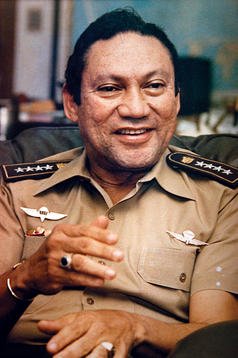 (CSmonitor.com) Filled with colorful chapters of revolution, civil unrest, and tin-pot tyrants, the history of Latin America has a way of repeating itself. So many Latin Americans keep one leery eye on the past at all times, acutely aware that it could sneak ahead into the future if the present is not managed properly.
(CSmonitor.com) Filled with colorful chapters of revolution, civil unrest, and tin-pot tyrants, the history of Latin America has a way of repeating itself. So many Latin Americans keep one leery eye on the past at all times, acutely aware that it could sneak ahead into the future if the present is not managed properly.
But Panamanians are an exception: relentlessly optimistic, loath to ponder their own recent history of iron-fisted rule under strongman Gen. Manuel Noriega, still known disparagingly on the streets of Panama as “pineapple face.”
Since Noriega was whisked away to face trial in Miami following the 1989 US invasion, the former dictator and his reign of terror have been mostly set aside by Panamanians. Freed from its olive-drab past, Panama has experienced rapid growth, with an economy growing near 10 percent and new buildings – including a Trump tower – shooting up across the skyline.
But the likely repatriation of Noriega, who has spent the past 21 years touring jail cells in Miami and Paris, could force this country to finally face its unpleasant past – and reflect on just how confident it feels about the future. (Noriega’s repatriation is set for Oct. 1, after his extradition was approved by a French judge on Friday.)
“Noriega managed to bring out the worst in people, using their needs, their fears, and their desperation. Panama is by no means way past this. Any scratch under the surface will bring memories out,” says Patrizia Pinzon, whose family was active in the anti-Noriega protests in the 1980s.
Noriega was seized by the United States during its 1989 invasion of Panama – sparked by violent run-ins between his thugs and US soldiers stationed at the canal – and sentenced to 20 years in prison in Miami on counts of drug trafficking, racketeering, and money laundering. Upon completing his US sentence last year, he was quickly extradited to France to face additional money laundering charges there.
But the Panamanian government intervened and requested Noriega’s return home to face murder charges. The French government agreed. Panamanian authorities have already prepared Noriega’s jail cell, and a government delegation is waiting for him to be released from French custody.
Debate over Noriega’s return
The extradition of the man who gave Panama its banana-republic image as a thuggish, corrupt country has some people worried – not so much about Noriega himself, but rather how the public will cope with his return and the memories it stirs.
“No one wants Noriega anymore – he’s got no more power,” says retired government employee Aristides Sánchez. Mr. Sánchez, who now drives a taxi, says two of his cousins were killed by Noriega’s thugs, but now the fear is gone. “Noriega has nothing here anymore, just another jail sentence waiting for him.”
Ms. Pinzon sees no reason to bring him back to Panama now. “Why would we want the worst of Panama back? Our judicial system is young still and this would be a difficult test to its integrity.”
Though Pinzon, now a community organizer, was only 13 at the time of the US invasion, she has vivid memories of political violence, restrictions to civil liberties, economic hardship, and the thuggish repression by Noriega’s paramilitary “dignity battalions.” She also remembers her mother keeping rags doused with vinegar to cover their mouths when clouds of tear gas fired at marching protesters wafted toward her house.
Others, however, think it’s good to remember the past. Tomás Herrera, a Panama City lawyer and dedicated Noriega opponent, can’t understand why the current government wants to bring him back. Still, he says, it will provide an opportunity for reflection.
“Panamanians should not forget those years…. This dark chapter in our history needs to be known and remembered by all future generations so it’s never repeated,” he says.
But already the younger generation seems to know Noriega only from the reminiscing of elder family members.
“I know he did a lot of bad things, but I just know him from history; I don’t know much about him personally,” says Jesus Toruño, a high school student who was born after the US invasion.
SOUND OFF on Facebook: How could a Noriega trial help Panama move forward?
‘Donald Trump is the future’
Still others are indifferent. Even in Noriega’s former military and political stronghold, the poor neighborhoods of El Chorrillo and Santana – wooden shantytowns that burned to the ground during the US invasion – sympathies are not what they were.
“The country has evolved and people could care less if he comes back or not,” says Felix McElfresh, an El Chorrillo resident.
Some of Noriega’s former political allies say the same. “This is a totally different country than the one that Noriega left,” says José I. Blandon, who served as Noriega’s top political adviser in the 1980s before testifying against him in front of a US Senate subcommittee in 2001.
“In his trip from the airport to jail, Noriega is going to look out the window and realize he doesn’t recognize Panama anymore,” he adds.
Mr. Blandon says that a July visit by New York real estate tycoon Donald Trump to Panama was a bigger headline for the country than Noriega’s possible return. Mr. Trump was there to inaugurate his $430 million Trump Ocean Club in Panama City.
Panamanian President Ricardo Martinelli hopes that Trump represents the future for Panama. “The Trump name will help Panama become a world icon,” he said.
But Noriega, if the extradition proceeds as scheduled, will only be a curiosity, says Blandon. “Trump is the future, and Noriega is the past,” Blandon says. “And there is a lot more love here for Trump.”
By Tim Rogers